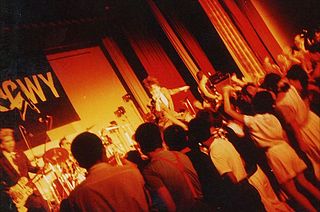Related Research Articles
Siam Shade was a five-piece Japanese rock band, formed in Tokyo in 1991. The classic line-up of Hideki on vocals, Natchin on bass, Kazuma and Daita on guitar, and Jun-ji on drums broke onto the visual kei scene alongside a multitude of other artists in the early 1990s and enjoyed a decade of relative popularity before disbanding in early 2002. The members have reunited several times since 2007 for one-off concerts and short tours. Outside Japan, Siam Shade is best known for "1/3 no Junjō na Kanjō", which was the sixth ending theme of the Rurouni Kenshin anime. Daita's work on their song "Triptych" was named the 83rd best guitar instrumental by Young Guitar Magazine in 2019.

Boøwy was a Japanese rock band formed in Takasaki, Gunma in 1981. The classic lineup of vocalist Kyosuke Himuro, guitarist Tomoyasu Hotei, bassist Tsunematsu Matsui, and drummer Makoto Takahashi reached legendary status in Japan during the 1980s.
Pierrot was a Japanese visual kei rock band formed in 1994 in Nagano. After changing their name from Dizy-Lizy to Pierrot and several member changes, the final lineup was completed in 1995 with Kirito on vocals, Jun and Aiji on guitar, Kohta on bass and Takeo on drums. After roughly ten years together, Pierrot disbanded in 2006. Their final single was named "Hello", an apt title for a band who started their major career with an album called Finale.

Mucc is a Japanese visual kei rock band, formed in Ibaraki in 1997. Named after a character from the children's TV show Hirake! Ponkikki, the band is also known by the nickname "69" since the numbers six and nine can be pronounced "mu" and "ku", respectively, in Japanese. As of 2020, the band has released 15 studio albums, two live albums, three EPs, 41 singles and 21 home videos, some of which were also released in Europe.

Hiroshi Morie, known exclusively by his stage name Heath, is a Japanese musician and singer-songwriter. He is the bass guitarist of the rock band X Japan. He joined the group in 1992 a few months after the ex-bassist Taiji Sawada left the band. Heath stayed with X Japan until the band's dissolution in 1997 and reunited with the band from 2007 onward.
Zigzo is a Japanese rock supergroup that originally started activities in 1999 and disbanded in 2002. Each member came from a prominent band and they became very popular in the indies scene. They disbanded after their last show on March 16, 2002, reportedly due to musical differences.

Jun Onose, better known by his stage name J, is a Japanese musician, singer, songwriter and record producer. He is best known as bassist and co-founder of the rock band Luna Sea since 1986. After they disbanded in 2000 he focused on his solo career, for which he performs lead vocals and bass. He rejoined Luna Sea when they reunited in August 2010.
Oblivion Dust is a Japanese rock band first active from 1996 to 2001, they reunited in 2007. Although they were originally largely influenced by early 1990s American grunge bands, since reuniting their music has become straight alternative rock. They stand out in the Japanese scene as most of their songs are written and sung in fluent English.

Kiyonobu Inoue, better known exclusively by his stage name Inoran, is a Japanese musician, singer and songwriter. He is best known as the rhythm guitarist and co-founder of the rock band Luna Sea since 1986. He started his solo career in 1997. Luna Sea disbanded in 2000, and he formed Fake? with Oblivion Dust vocalist Ken Lloyd a year later. In 2005 he left Fake? and founded Tourbillon with Luna Sea vocalist Ryuichi Kawamura and Hiroaki Hayama. He rejoined Luna Sea when they reunited in 2010, and in 2012 formed Muddy Apes with bassist Taka Hirose and guitarist Dean Tidey, both from Feeder, and 8otto's vocalist Maeson.

The discography of the Japanese heavy metal band X Japan consists of five studio albums, six live albums, one remix album, eleven compilations, one soundtrack album, 23 singles, and around 22 live video recordings.
Bow Wow are a Japanese rock band formed in 1975. Originally consisting of guitarist and vocalists Kyoji Yamamoto and Mitsuhiro Saito, bassist Kenji Sano and drummer Toshihiro Niimi, they were one of the first Japanese metal bands. After releasing nine studio albums, Saito left in 1983. The band then adopted a mainstream sound by recruiting lead vocalist Genki Hitomi and keyboardist Rei Atsumi and renamed themselves to Vow Wow. They relocated to England in 1986, before Sano left the band the following year and Yamamoto invited former Whitesnake bassist Neil Murray to replace him. After Murray left to join Black Sabbath, studio bassist Mark Gould played on Vow Wow's last album before they disbanded in 1990.

Ryuichi Kawamura is a Japanese singer, songwriter, record producer, actor and author. He is best known as lead singer of the rock band Luna Sea since 1989. He started a solo career in 1997, three years before Luna Sea disbanded in 2000. In 2005, Kawamura formed Tourbillon with fellow Luna Sea member Inoran and Hiroaki Hayama. He rejoined Luna Sea when they reunited in August 2010.
La'cryma Christi was a Japanese visual kei rock band originally active from 1991 to 2007. At their peak, they were considered one of "the big four of visual kei" alongside Fanatic Crisis, Malice Mizer and Shazna. They reunited for a concert in 2009 at the V-Rock Festival, for their short reunion tour in 2010, and for a 15th anniversary tour in 2012.
Acid Black Cherry is the solo project of the former lead vocalist of Janne Da Arc, Yasu. The group was formed after Janne Da Arc announced their indefinite hiatus.

The discography of Versailles, a Japanese visual kei metal band formed in 2007 by vocalist Kamijo and guitarist Hizaki. After recruiting bassist Jasmine You, drummer Yuki and guitarist Teru, they performed their first show on June 23. Their key characteristics are their Rococo-esque costumes, dueling guitars and heavy but melodic arrangements. Versailles gained a significant worldwide following soon after forming as their debut EP Lyrical Sympathy (2007), released by Kamijo's own label Sherow Artist Society, received a simultaneous European release and they performed in Europe and the United States the following year. Their first full-length album, Noble released in 2008, was also released in North America in 2009.
Gastunk is an influential Japanese rock band, first active from 1983 to 1988. Initially a hardcore punk band, guitarist Tatsu later recalled that when Gastunk made their major label debut they were dubbed heavy metal by the media. They reunited for one-off concerts in 1999 and 2006, before fully restarting activities in 2010.

Beautiful Deformity is the seventh studio album by Japanese visual kei rock band The Gazette, released on October 23, 2013 in Japan by Sony Music Records and in the UK, Europe and Russia by JPU Records. It includes the single Fadeless.

Japanese musician Yoshiki has released 3 solo studio albums as of April 2017 and is credited as a songwriter, producer or arranger for a number of artists. Chart rankings are weekly, unless otherwise stated.
The following is the discography of hide, a Japanese rock musician who first gained fame in the late 1980s as lead guitarist of the heavy metal band X Japan before starting his solo career in 1993. Prior to X Japan, hide was leader and guitarist of the heavy metal band Saber Tiger, who released one self-titled EP in July 1985 and contributed to two omnibuses before ending activities. Although two compilation albums of demos and live recordings and one concert VHS would later be released in 2001, with the band credited as Yokosuka Saver Tiger.
Hisato Takenaka, known professionally as Char, is a Japanese musician, singer-songwriter and record producer. He is considered one of Japan's greatest guitar players.